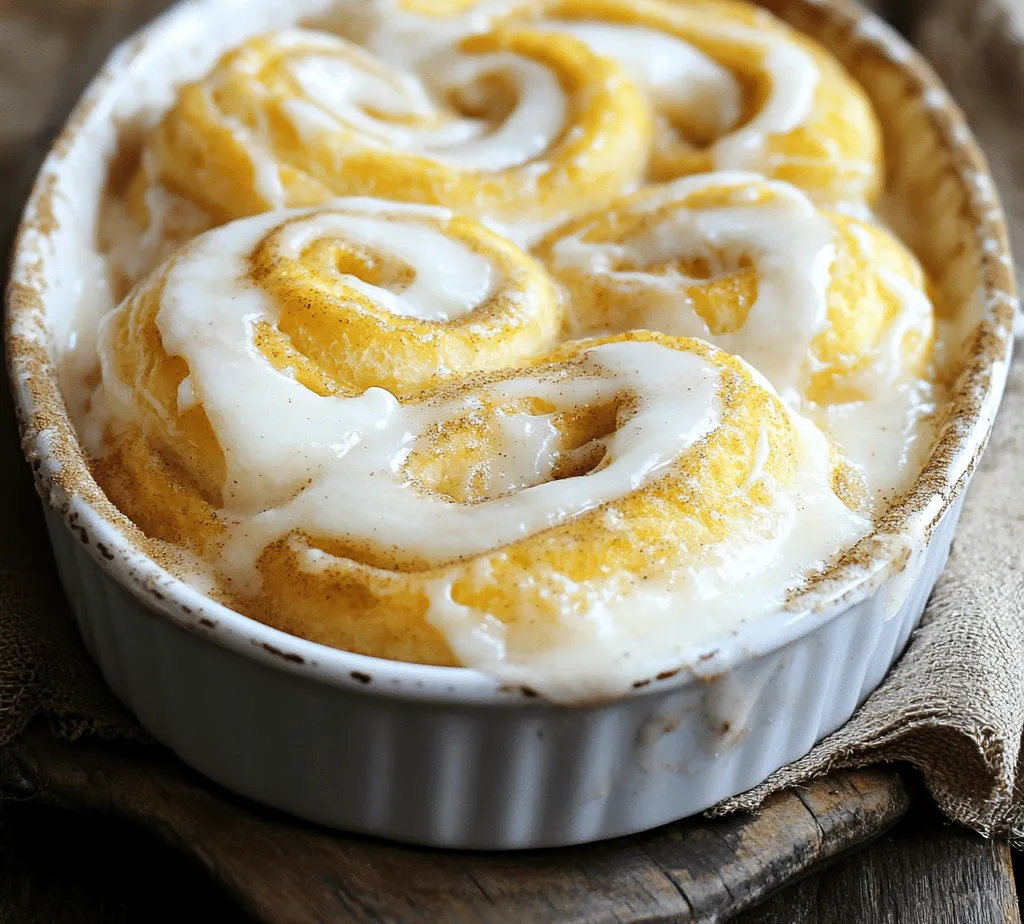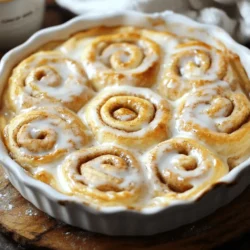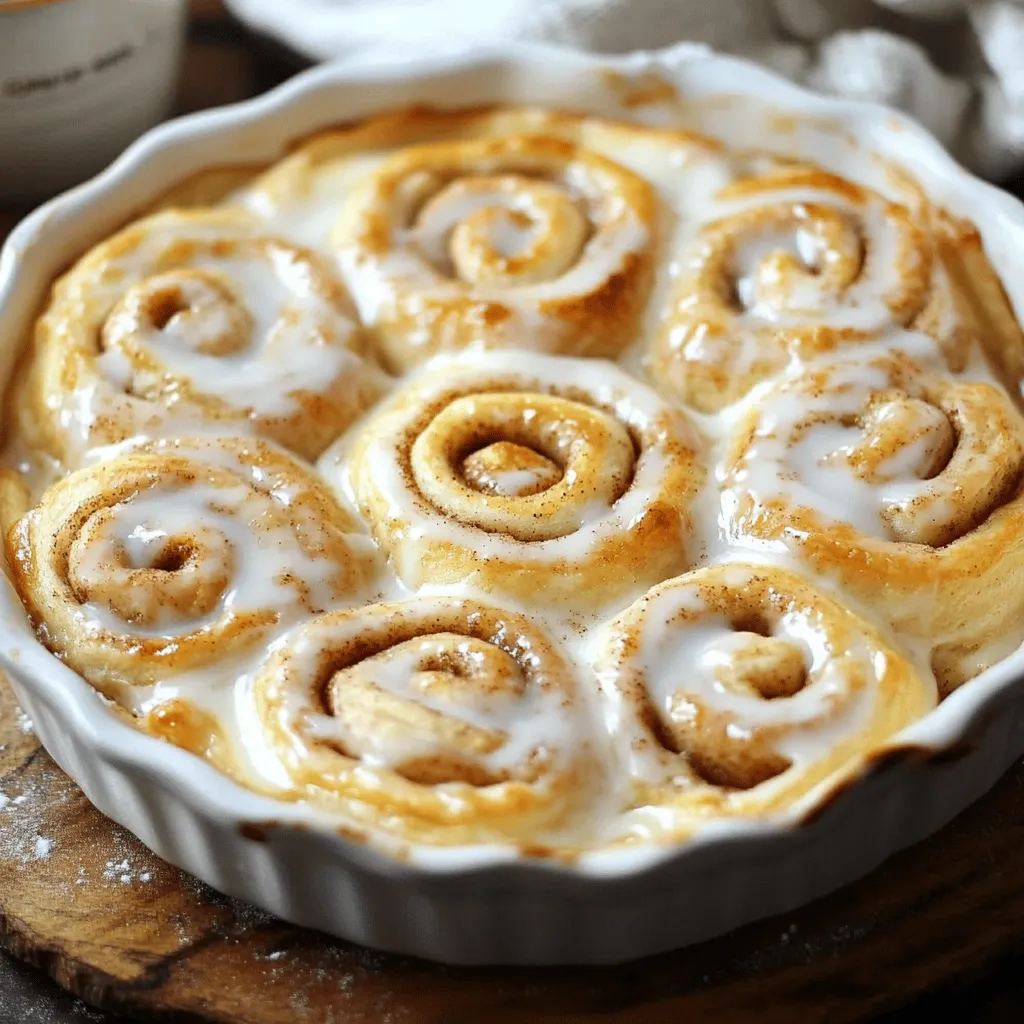Introduction
Cinnamon rolls have long been cherished as a comforting treat, evoking nostalgia and warmth with every bite. Their irresistible aroma wafting through the kitchen can transform a typical morning into a special occasion. Whether enjoyed during a leisurely weekend brunch, a festive holiday gathering, or simply as a cozy afternoon snack, cinnamon rolls hold a special place in the hearts of many. The combination of fluffy dough, sweet cinnamon filling, and creamy glaze creates a delight that is hard to resist.
While store-bought options may offer convenience, there’s something truly magical about making cinnamon rolls from scratch. Homemade cinnamon rolls allow you to control every ingredient, ensuring freshness and quality. The ability to customize flavors—from adding nuts and raisins to experimenting with different glazes—makes the process even more rewarding. The joy of baking, combined with the satisfaction of pulling a tray of golden, gooey cinnamon rolls from the oven, is an experience that everyone should savor.
In this article, we will guide you through the process of creating heavenly homemade cinnamon rolls. Expect a detailed recipe with step-by-step instructions, along with insights into the baking process that will help you achieve perfect results. Whether you’re a novice baker or a seasoned pro, you’ll find valuable tips to elevate your cinnamon roll game.
Understanding the Ingredients
To create the best homemade cinnamon rolls, it’s essential to understand the key ingredients that contribute to their deliciousness. Each element plays a vital role in the overall structure, flavor, and texture of the final product. Here’s a closer look at the ingredients you’ll need:
All-Purpose Flour
The foundation of any good cinnamon roll is its dough, and all-purpose flour is the star of the show. This versatile flour provides the necessary structure for the dough, giving it elasticity and strength. When combined with liquid and kneaded, the proteins in the flour develop gluten, which is crucial for achieving that chewy, satisfying texture we all love in cinnamon rolls. Choosing the right flour is key; all-purpose flour strikes a balance between softness and strength, making it ideal for this recipe.
Active Dry Yeast
Yeast is the magic ingredient that transforms a simple dough into a soft, fluffy delight. Active dry yeast is a type of leavening agent that ferments and produces carbon dioxide when activated. This fermentation process causes the dough to rise, creating air pockets that result in that light, airy texture. It’s important to handle the yeast correctly, as it requires warm water to activate and thrive. If you’ve ever wondered why some cinnamon rolls are dense while others are pillowy soft, the answer often lies in the yeast.
Whole Milk and Unsalted Butter
Dairy ingredients, such as whole milk and unsalted butter, add richness and moisture to cinnamon rolls. Whole milk not only contributes to the dough’s tenderness but also enhances flavor. Unsalted butter is used for its creamy texture and ability to impart a buttery taste that complements the sweetness of the filling. When melted and incorporated into the dough, these ingredients help create that soft, melt-in-your-mouth experience that makes cinnamon rolls so irresistible.
Sugar
Sugar plays a dual role in cinnamon rolls. Granulated sugar is combined with the dough to provide sweetness, while brown sugar is used in the filling. The molasses content in brown sugar adds depth of flavor, creating a rich caramel-like taste that pairs perfectly with the cinnamon. Additionally, sugar helps to brown the rolls during baking, giving them that appealing golden color. The balance between granulated and brown sugar is essential for achieving the perfect blend of sweetness.
Ground Cinnamon
No cinnamon roll would be complete without its namesake spice. Ground cinnamon is what gives these rolls their signature flavor and aroma. Its warm, sweet, and slightly spicy notes are what make cinnamon rolls so comforting and nostalgic. When combined with sugar in the filling, cinnamon creates a delightful swirl that is both visually appealing and delicious.
Powdered Sugar and Vanilla Extract
To finish off your heavenly cinnamon rolls, a glaze made from powdered sugar and vanilla extract adds the perfect touch of sweetness. Powdered sugar, when mixed with milk or cream, forms a smooth glaze that drapes beautifully over the warm rolls. The addition of vanilla extract not only enhances the flavor but also contributes to the overall aroma. This final touch is what elevates your cinnamon rolls from delicious to truly decadent.
The Science Behind Cinnamon Roll Dough
Understanding the science behind cinnamon roll dough can significantly improve your baking results. The foundation of this process lies in fermentation, kneading, and rising times.
Fermentation Process with Yeast
When you mix yeast with warm water and sugar, you kick-start the fermentation process. Yeast feeds on the sugar, producing carbon dioxide and alcohol as byproducts. This process not only causes the dough to rise but also develops flavor. The longer the dough ferments, the more complex its flavor becomes. Allowing the dough to rise in a warm, draft-free environment is crucial for achieving optimal results.
Importance of Kneading
Kneading is an essential step in developing the dough’s gluten structure. As you knead the dough, the gluten proteins align and form long strands, creating a network that traps air bubbles. This network is what gives cinnamon rolls their chewy texture. Proper kneading ensures that the dough is smooth and elastic, which will lead to a better rise during the fermentation process.
Rising Times
Rising times are critical in achieving the ideal fluffiness of your cinnamon rolls. After kneading, the dough is allowed to rise until it doubles in size. This rising period is crucial as it allows the yeast to work its magic. Once shaped and filled, the rolls should rise again before baking, ensuring that they are light and airy. Be patient during this process—rushing the rising times can lead to denser rolls.
Step-by-Step Instructions for Heavenly Cinnamon Rolls
Now that you have a solid understanding of the ingredients and the science behind the dough, let’s dive into the step-by-step instructions for making heavenly homemade cinnamon rolls. The first step involves activating the yeast, which is key to a successful rise.
Activating the Yeast
1. Gather Your Ingredients: Before you start, make sure you have all your ingredients ready. You’ll need active dry yeast, warm water, sugar, and a pinch of salt.
2. Warm the Water: Heat about 1/4 cup of water to around 110°F (43°C). This temperature is ideal for activating the yeast—too hot, and you risk killing it; too cold, and it won’t activate properly.
3. Mix the Yeast: In a small bowl, combine the warm water with 1 teaspoon of granulated sugar (this serves as food for the yeast) and 2 1/4 teaspoons of active dry yeast. Stir gently to combine.
4. Let It Sit: Allow the mixture to sit for about 5-10 minutes. You’ll notice the yeast starting to foam and bubble, indicating it’s alive and ready to use. If there’s no foam, your yeast may be inactive, and you’ll need to start over with fresh yeast.
5. Combine with Dry Ingredients: In a large mixing bowl, combine 4 cups of all-purpose flour, 1/4 cup of granulated sugar, and 1 teaspoon of salt. Mix these dry ingredients thoroughly to ensure even distribution.
6. Add the Yeast Mixture: Once your yeast is activated, pour it into the bowl with the dry ingredients, along with 1/2 cup of melted unsalted butter and 1 cup of whole milk (warmed to about 110°F).
7. Mix and Knead: Using a wooden spoon or a stand mixer fitted with a dough hook, mix the ingredients until a dough forms. Once combined, transfer the dough to a floured surface and knead it for about 5-7 minutes until it becomes smooth and elastic.
With these initial steps completed, you’re well on your way to creating your heavenly homemade cinnamon rolls. Stay tuned for the next parts, where we’ll explore shaping, filling, and baking these delightful treats. The process may take some time, but the results will be well worth the effort—soft, sweet, and utterly irresistible cinnamon rolls that are sure to impress family and friends alike.

Making the Dough: A Comprehensive Guide on Mixing and Kneading Techniques
The foundation of any great cinnamon roll lies in the dough. To achieve that pillowy softness, start by mixing the warm milk, sugar, and yeast in a large mixing bowl. Allow this mixture to sit for about 5-10 minutes until it becomes frothy, indicating that the yeast is active. Next, add in melted butter, eggs, and a pinch of salt, stirring until combined.
Gradually incorporate the flour, one cup at a time, mixing until a sticky dough forms. At this stage, you may need to switch to using your hands or a stand mixer fitted with a dough hook. Kneading the dough is crucial; work it for about 8-10 minutes until it’s smooth and elastic. If the dough is too sticky, add flour incrementally, but be cautious not to overdo it. A well-kneaded dough should spring back when poked and have a slight tackiness without being overly sticky.
The First Rise: What to Look For to Ensure Proper Fermentation
After kneading, place the dough in a lightly greased bowl, cover it with plastic wrap or a clean kitchen towel, and set it in a warm area to rise. The ideal temperature for rising dough is around 75-80°F (24-27°C). Allow the dough to rise until it has doubled in size, typically taking about 1-2 hours depending on the warmth of your kitchen. To check if it’s ready, gently press your finger into the dough; if the indentation remains, it’s time to move on to the next step.
Preparing the Filling: Creating the Perfect Cinnamon-Sugar Mixture
While the dough rises, prepare the cinnamon-sugar filling. In a medium bowl, combine 1 cup of packed brown sugar, 2 tablespoons of ground cinnamon, and a pinch of salt. This mixture is what gives your cinnamon rolls their signature sweetness and flavor. For an added depth of flavor, consider incorporating a teaspoon of nutmeg or even a splash of vanilla extract into the filling.
Rolling Out the Dough: Advice on Achieving the Right Thickness and Size
Once the dough has risen, punch it down gently to release the air. Transfer it to a floured surface and roll it out into a rectangle approximately 16×24 inches and about 1/4 inch thick. The key to achieving the right thickness is to use even pressure with your rolling pin and to keep the dough floured to prevent sticking. If the dough resists rolling out, let it rest for a few minutes before continuing.
Spreading Butter and Filling: Techniques for Even Distribution
Next, spread about 1/2 cup of softened unsalted butter evenly across the surface of the rolled-out dough. Ensure the butter reaches the edges for maximum flavor in each bite. After buttering, sprinkle your cinnamon-sugar mixture generously over the buttered surface, leaving a small border around the edges. This will help the filling stay intact when you roll it up.
Forming the Rolls: Cutting Methods for Uniformity and Presentation
To form the rolls, begin at one long edge of the rectangle and carefully roll the dough away from you, creating a tight log. Once rolled, use a sharp knife or dental floss to cut the log into 12 equal sections. For perfect slices, use a sawing motion rather than pressing down hard, which can squish the rolls. Place the cut rolls in a greased baking dish, leaving a little space between each one to allow for expansion during the second rise.
The Second Rise: Importance in Achieving the Final Fluffiness and Volume
Cover the rolls with a kitchen towel and let them rise again in a warm spot for about 30-45 minutes. This second rise is crucial as it allows the rolls to puff up and become airy. Look for the rolls to double in size, and make sure they’re touching each other slightly to create that classic cinnamon roll shape.
Baking the Rolls: Tips for Determining Doneness and Achieving a Golden-Brown Finish
Preheat your oven to 350°F (175°C) while the rolls are rising. Once they have risen adequately, bake them in the preheated oven for about 25-30 minutes. Keep an eye on them, and when they turn a beautiful golden-brown color, check for doneness by inserting a toothpick in the center; it should come out clean or with a few moist crumbs. Avoid overbaking, as this can lead to dry rolls.
Creating the Perfect Glaze
Ingredients and Techniques for Making a Smooth Glaze
While the rolls are baking, whisk together 1 cup of powdered sugar, 2 tablespoons of milk, and 1/2 teaspoon of vanilla extract in a small bowl until smooth. Adjust the consistency by adding more milk for a thinner glaze or additional powdered sugar for a thicker one. The ideal glaze should be pourable but not too runny.
The Impact of Glaze on Flavor and Presentation
The glaze adds a sweet, creamy finish to your cinnamon rolls, enhancing their appeal both visually and in taste. The contrast of the white glaze against the golden-brown rolls makes for a stunning presentation that is sure to impress your guests.
Tips for Glazing Rolls While Warm to Enhance Flavor Absorption
For the best flavor absorption, drizzle the glaze over the rolls while they are still warm. This allows the glaze to seep slightly into the rolls, creating a deliciously sweet bite. Use a spoon or a piping bag to evenly distribute the glaze over the top.
Serving Suggestions
Ideas for Pairing Cinnamon Rolls with Beverages
Cinnamon rolls are the perfect treat for breakfast, brunch, or even dessert. Pair them with a hot cup of coffee, a soothing cup of tea, or a refreshing glass of milk. The rich, buttery sweetness of the rolls complements the warmth of coffee beautifully, while a cup of herbal tea offers a light, fragrant counterpoint.
Suggestions for Variations in Serving: Toppings, Fillings, and Flavor Twists
Feel free to get creative with your cinnamon rolls! Consider adding nuts, such as chopped pecans or walnuts, into the filling for an extra crunch. You could also experiment with different fillings like apple pie filling or chocolate chips for a delectable twist. For a festive touch, sprinkle some chopped cranberries or orange zest over the top before rolling.
Discussion on Storing Leftover Rolls: Methods to Keep Them Fresh
If you have any leftover rolls (though they’re unlikely to last long), store them in an airtight container at room temperature for up to 2 days. For longer storage, consider freezing them. Wrap each roll in plastic wrap and then place them in a freezer-safe bag. When you’re ready to enjoy, simply thaw them at room temperature and warm them in the oven for a few minutes before glazing.
Conclusion
There’s something incredibly satisfying about the process of making and enjoying homemade cinnamon rolls. From the fragrant aroma that fills your kitchen to the delight of biting into a soft, gooey roll, each step is a labor of love. Not only do you create a delicious treat, but you also make lasting memories with family and friends as you share your creation.
We encourage you to try this recipe and experience the joy of baking these heavenly cinnamon rolls. The delightful combination of flavors and textures is sure to become a favorite in your household. So gather your ingredients, roll up your sleeves, and get ready to enjoy the satisfaction that comes from baking and sharing these irresistible treats with your loved ones. Happy baking!


